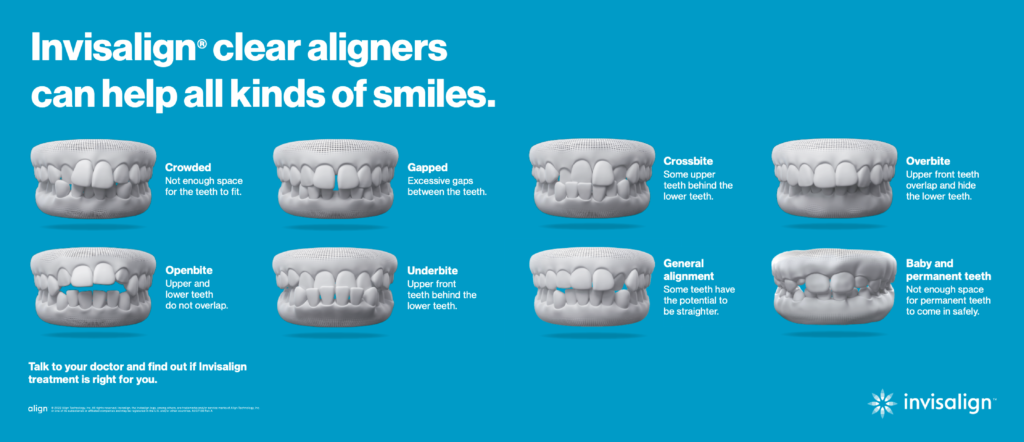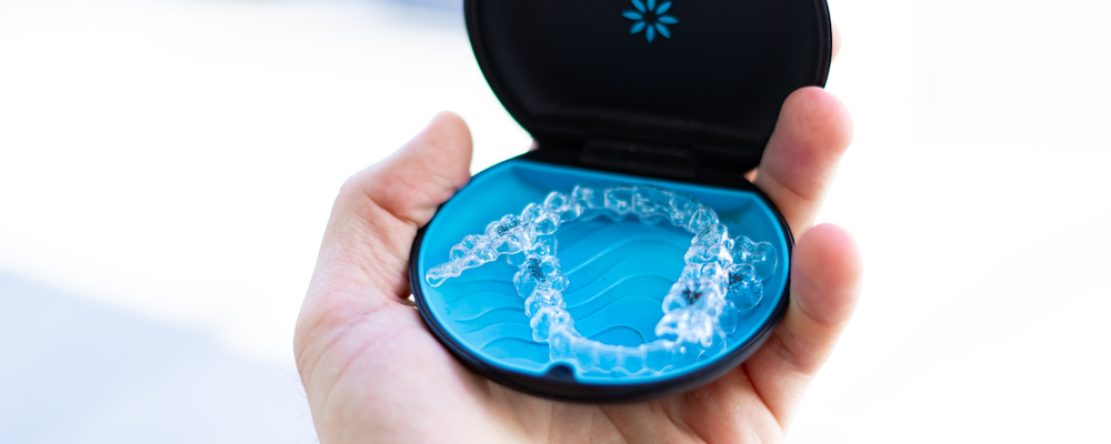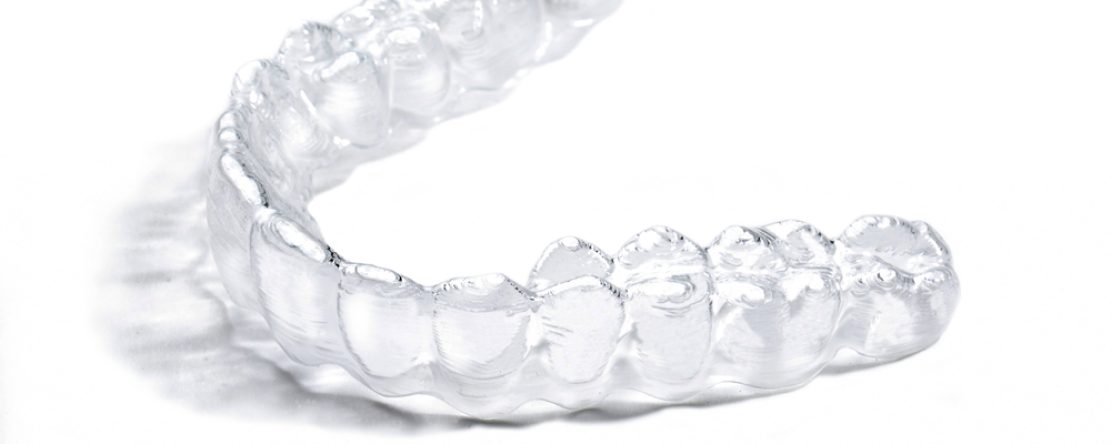All you need to know about INVISALIGN
Invisalign:
Given the choice, would you opt for braces or clear aligners for teeth straightening? If clear aligners are your preference, you’re in good company. Over the past few decades, Invisalign has surged in popularity as a method for aligning teeth.
Among the pioneering clear aligner products is Invisalign, which hit the market in 1998 courtesy of Align Technology. Since then, various other brands like Zenyum, ClearCorrect, and SmileMe have entered the market with their clear aligner offerings.
Let’s delve into the capabilities of Invisalign, and its effectiveness, and weigh its pros and cons.

What dental conditions do Invisalign address?
Invisalign is versatile, capable of addressing concerns like crowding, spacing irregularities, and certain mild to moderate bite issues.
The Invisalign website claims that it can be used to treat the following dental issues:
- open bite
- crowded teeth
- gap teeth
- some types of overbite, underbite, and crossbite issues
Crooked teeth
Crooked teeth refer to misaligned or irregularly positioned teeth that deviate from the normal alignment or straight pattern within the dental arch. This condition can manifest as teeth that are rotated, crowded, or tilted, leading to an uneven appearance in the smile. Crooked teeth can result from factors such as genetics, inadequate jaw space, early loss of primary teeth, or oral habits. Orthodontic treatments, like braces or clear aligners, are often employed to correct the alignment of crooked teeth for both functional and aesthetic purposes.
Crowded teeth
Crowded teeth occur when there is insufficient space in the dental arch to accommodate all the teeth properly. This can lead to teeth being tightly packed, overlapping, or twisted within the available space. Crowding can result from a variety of factors, including genetics, insufficient jaw size, or early loss of primary teeth. Crowded teeth may pose challenges for maintaining proper oral hygiene and can contribute to issues such as tooth decay or gum disease. Orthodontic interventions, like braces or clear aligners, are commonly used to address crowded teeth by gradually repositioning them for improved alignment and function.
Gapped teeth
Gapped teeth, also known as diastema, refer to the presence of noticeable spaces or gaps between two or more teeth within the dental arch. These spaces can occur anywhere in the mouth but are often seen between the upper front teeth. Gapped teeth can result from various factors, including differences in tooth size, missing teeth, or discrepancies in jaw size. While some people embrace the unique aesthetics of gapped teeth, others may seek orthodontic treatments, such as braces or clear aligners, to close the gaps for both cosmetic and functional reasons.
Malocclusion
(Issues with the way your teeth fit together). Malocclusion is a dental term that refers to the misalignment or incorrect positioning of the teeth when the jaws are closed. It essentially means that the upper and lower teeth do not fit together properly, leading to issues with the bite. Malocclusion can manifest in various forms, such as overbite, underbite, crossbite, or open bite, and it can result from factors like genetics, thumb-sucking habits, early loss of teeth, or jaw misalignment. Orthodontic treatments are often used to correct malocclusion, improving both the functional and aesthetic aspects of the bite and smile.
“A clear alternative to braces.” – Dr. Carmen
How much fun do you have while wearing them?
Ready to start your journey to a perfect smile? Let’s get playful! First, you’ll visit our awesome Dr. with Invisalign certified provider in PrimeCare Dental Clinic who will use cutting-edge technology to create a 3-D image of your mouth and jaw. From there, it’s all about customizing a series of funky plastic aligners that will give your teeth a serious workout. You’ll switch ’em up every week or two, wearing them for 20-22 hours a day – but don’t worry, it’ll be a cool and groovy experience!

How much does Invisalign cost?
The pricing for Invisalign varies depending on individual cases, with factors such as the extent of teeth misalignment and consultation fees contributing to the overall cost. While some dental clinics may offer a complimentary pre-assessment, others may not. Hence, there’s no fixed cost for Invisalign in Malaysia. However, typical Invisalign treatments can range into the five-digit figures from RM 9”800 – 26’000.
Will there be discounts for Invisalign?

At PrimeCare Dental Clinic, we occasionally receive RM500 rebate vouchers from Invisalign as a promotional offer to assist providers in attracting new patients.
As a bonus to new patients for our PrimeCare Dental Clinic, we are offering an additional RM500 rebate, resulting in a total of RM1000 discount on your Invisalign treatment.
[Sassy_Social_Share title=”Share this post to:”]
Please click the button below to redeem and determine if you qualify for this exclusive reward.
Several factors can influence the effectiveness of Invisalign:
Consistent Wear:
Invisalign requires wearing aligners for 20 to 22 hours daily, removing them only for eating, drinking, brushing, flossing, and cleaning. Warping the plastic by using very hot water during cleaning can compromise the fit and impact progress.
Orthodontic Complexity:
The severity of spacing or bite issues affects treatment duration. More complex cases may require a longer duration for optimal results.
Age and Gender:
Research suggests age and gender may play a role in tooth movement during treatment. Tooth movement tends to increase slightly between ages 15 to 60, potentially making Invisalign more effective for this age group. Additionally, tooth movement patterns may differ between genders, with implications for treatment effectiveness.

Let’s explore the advantages and disadvantages of Invisalign to assist you in determining if it’s the right choice for you.
Pros of Invisalign:
- Aesthetic Appeal: Invisalign’s clear aligners are often preferred for their discreet appearance, as they are less noticeable compared to traditional braces with wires and brackets.
- Removability: Invisalign aligners can be easily removed when necessary, providing greater flexibility and convenience.
- Enhanced Oral Hygiene: Removal of the aligners allows for easier brushing and flossing, potentially improving periodontal health by reducing bacteria accumulation around teeth and gums, as indicated by a 2017 study.
- Reduced Potential Issues: Unlike traditional braces, Invisalign aligners typically involve fewer problems like brackets falling off or wires breaking, minimizing the need for emergency orthodontic visits.
Drawbacks of Invisalign:
- Limited Effectiveness for Complex Issues: While research is somewhat limited, it suggests that Invisalign may be less effective for individuals requiring extensive teeth movement or those with bridgework. Your dentist may recommend alternative treatments for more intricate issues.
- Compliance Requirement: In order to achieve optimal results with Invisalign, strict adherence to wearing the aligners for 20 to 22 hours daily is necessary. If you anticipate difficulty in maintaining this level of compliance, Invisalign may not be the most suitable option for you.
- Removal for Eating and Drinking: Aligners must be removed when eating or drinking to prevent food particles or liquids from accumulating, which can lead to bacterial growth and potentially cause cavities. Additionally, liquid intake can result in staining of both the aligners and teeth.
- Food Restrictions: Removing the aligners may cause tooth soreness, limiting food choices, particularly hard foods, which should be avoided to prevent discomfort.
Is Invisalign suitable for me?
If you can’t sleep and you’re contemplating Invisalign aligners, consider these questions to gauge if they aligns with your needs:
- Do I have relatively straightforward crowding or bite issues with my teeth?
- Am I self-conscious about the visibility of traditional braces?
- Can I commit to wearing the aligners for the prescribed duration each day?
- Is the cost within my budget?
- Will I be diligent in caring for the aligners properly?
For parents with teenagers considering Invisalign over traditional braces, assess their willingness to wear and care for the aligners. If your child has a tendency to misplace items, the removable nature of Invisalign may not be the most suitable option.
About Us
Let our dedicated dentist at PrimeCare Dental Clinic inspire you with personalized care and a genuine commitment to putting a bright smile on your face. Experience the warmth and expertise that make our dental practice truly special.
Recent Post
Newsletter
Other Categories:
Post Tags: